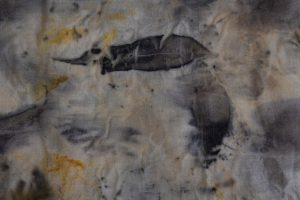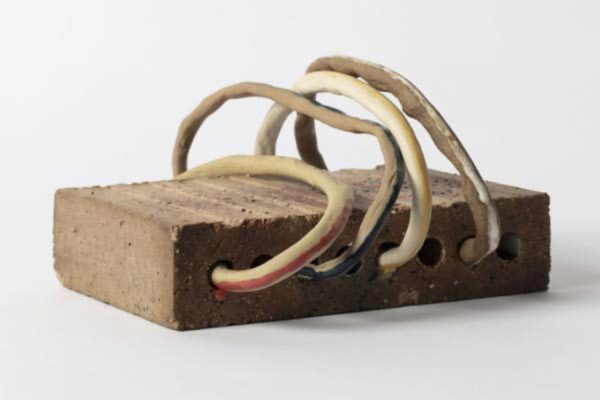Review: Tami Xiang, Esther McDowell/Yabini Kickett, Tom Freeman, Lisa Liebetrau, ‘August exhibitions’ ·
Cool Change Contemporary ·
Review by Stephen Bevis ·
The Bon Marché Arcade Building on Barrack Street was once one of the grandest spots in Perth. Built in 1895 by a former convict who made good as a bookseller, its fortunes have reflected the dramatic shifts in commercial, retail and social behaviour over the decades.
In its heyday, it was a popular link from Barrack Street to the now defunct Bon Marché drapery and department store, which ran between Hay and Murray Streets before being sold off to David Jones in 1954 and eventually demolished. Now Bon Marché is an arcade to nowhere. Many of its rooms are empty, although a few small businesses keep its spirit alive. So too does the artist-run initiative Cool Change Contemporary, which is celebrating one year of revitalising this often overlooked premises with its rolling program of residencies, exhibitions, workshops and events.
Bon Marché’s colourful and varied history is a rich well for Cool Change artist-in-residence Lisa Liebetrau to draw from in her site-responsive works and archival ephemera that evoke the stories, memories and characters that inhabit the once-bustling mercantile rooms. Liebetrau reflects on the building’s life cycle from grand openings to bargain-bin discounts, decline and possible renewal led by the artists who now inhabit this space. The Bon Marché story is just one of many in Perth as economic disruption pock-marks the city’s face with empty retail tenancies.
As Liebetrau’s catalogue notes say, “the transitory nature of artist-run initiatives cultivates the opportunity for marginal spaces and neglected buildings to breathe new life into them and allow their past to gain new visibility”.
Occupying the main space at Cool Change, Tami Xiang also considers the impact of shifting currents of economic and social fortunes in her show “Peasantography Lucky 88”. This is the latest in the Chinese-Australian artist’s “Peasantography” series on the disruptive effects of the Chinese economic “miracle” and the Hukou household classification system assigning people rural or urban roles. Many millions have been lifted from poverty in China but this has involved an exodus of working-age people from rural regions to the cities under the Hukou system. The result has been a hollowing out of villages and towns across the Chinese countryside, with children left with grandparents while the parents take up work in the industrial cities.
Last year, Xiang’s “Peasantography Family Portrait” show at UWA’s Cullity Gallery focused on the Chinese families split along generational lines. It was a powerful, dystopian collection of images of “absent” urban parents paired with photographs of their children nestling in the arms of elderly carers.
With “Peasantography Lucky 88”, Xiang has zoomed in on the aging rural poor. Unable to work, their pensions are linked to the ubiquitous two-tier Hukou classification which applies a rural welfare payment of 88 yuan ($18), a rate which until recently was much less than that received by their counterparts in the city.
Xiang has photographed a series of retired peasant farmers against a red studio background with the meagre objects they have purchased with 88 yuan. The number is considered lucky in Chinese numerology and, despite their privations, many of Xiang’s subjects consider themselves fortunate to get a pension at all, having endured the worst extremes of the Great Leap Forward and Cultural Revolution. There is a poignant nobility about these images, as Xiang’s dislocated subjects stand in dirty footwear on pristine red studio sheets and stare impassively at the viewer while clutching their purchased goods.
Displacement and the significance of objects imbued with meaning also feature in “Kala Koorliny – Going Home” by Esther McDowell/Yabini Kickett. The Balladong Noongar artist has created a series of textiles, hanging installations and works on paper using natural materials collected while moving through country.

McDowell has incorporated marri leaves, feathers, gum nuts and even a small animal skull in her work, which includes three Moort Boodja dresses created and worn as a salve to homesickness in her own land. This wearable art enables the artist to carry her country with her to offset the on-going disruption to Noongar country. Kata Lines, a series of four drawings on paper using eucalyptus dyes, pastel and ink, represent her family’s passage through the Darling Scarp (Kata Mordo) in flowing compositions of place and knowledge.
Sitting comfortably in a building oozing with history and memory is Tom Freeman’s “Brick”, a playful, layered tribute to the metamorphic qualities of the material which built this city. Freeman incorporates stray bricks retrieved from around Perth and reimagines their qualities, both in form and function.
Referencing the malleable properties of source clay, Freeman introduces sensuous ceramic extrusions, glazes and plastics to create characters and stories for these inanimate building blocks. He experiments in scale and context to dream of alternate states and purposes for these humble, utilitarian objects.

These four exhibition are all highly rewarding in their own right but the connections between them strongly speak of the relationship between “progress” and its impact on the places we inhabit and the people we connect with.
Walking back down the narrow stairs from the ARI into the arcade and streetscape below, and beginning to reflect on the exhibitions above, I found myself reaching out to touch the textured brickwork and thinking, “If only these walls could talk”. In a way, they have – thanks to the artists of Cool Change.
Picture above: Tami Xiang’s “Peasantography: Lucky 88” at Cool Change Contemporary.
Like what you're reading? Support Seesaw.





